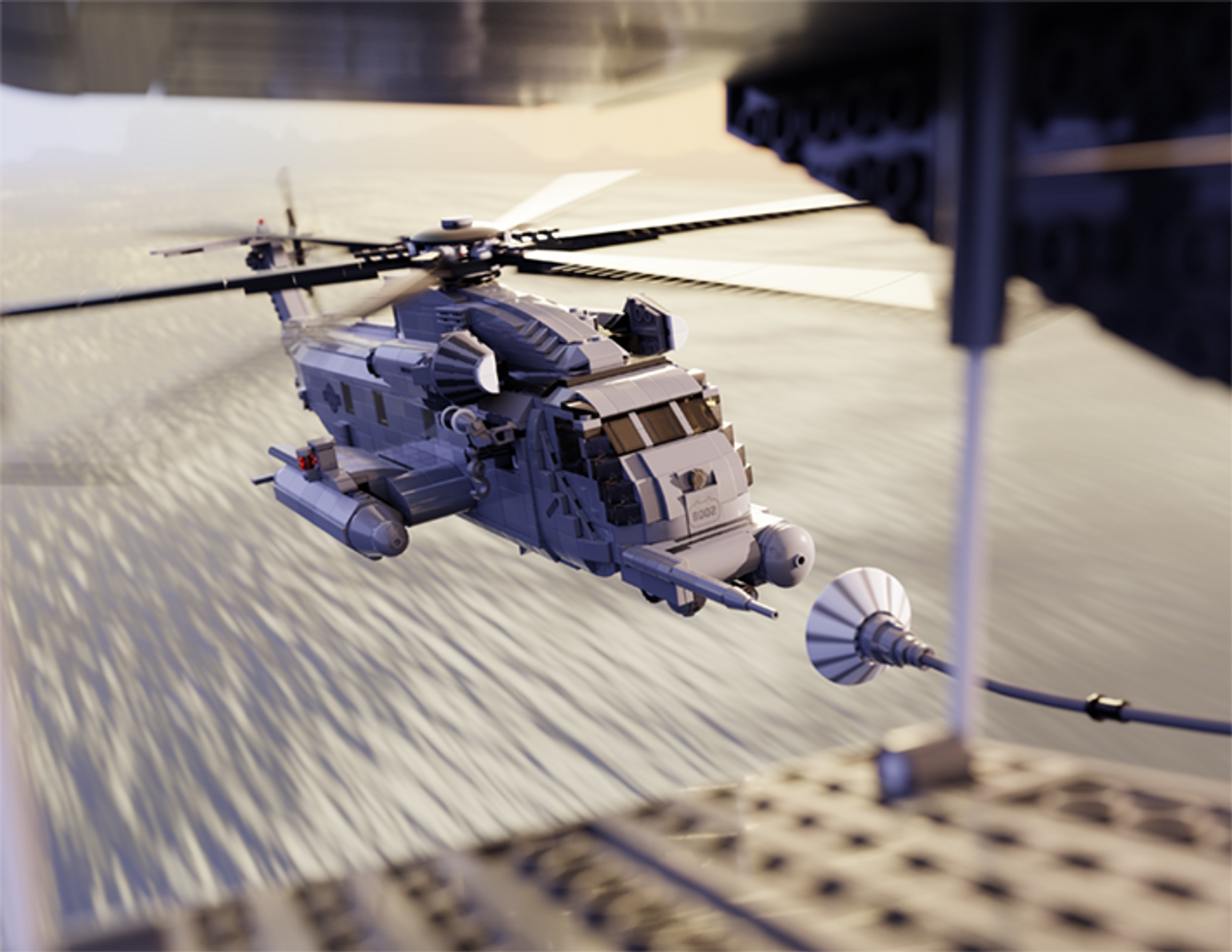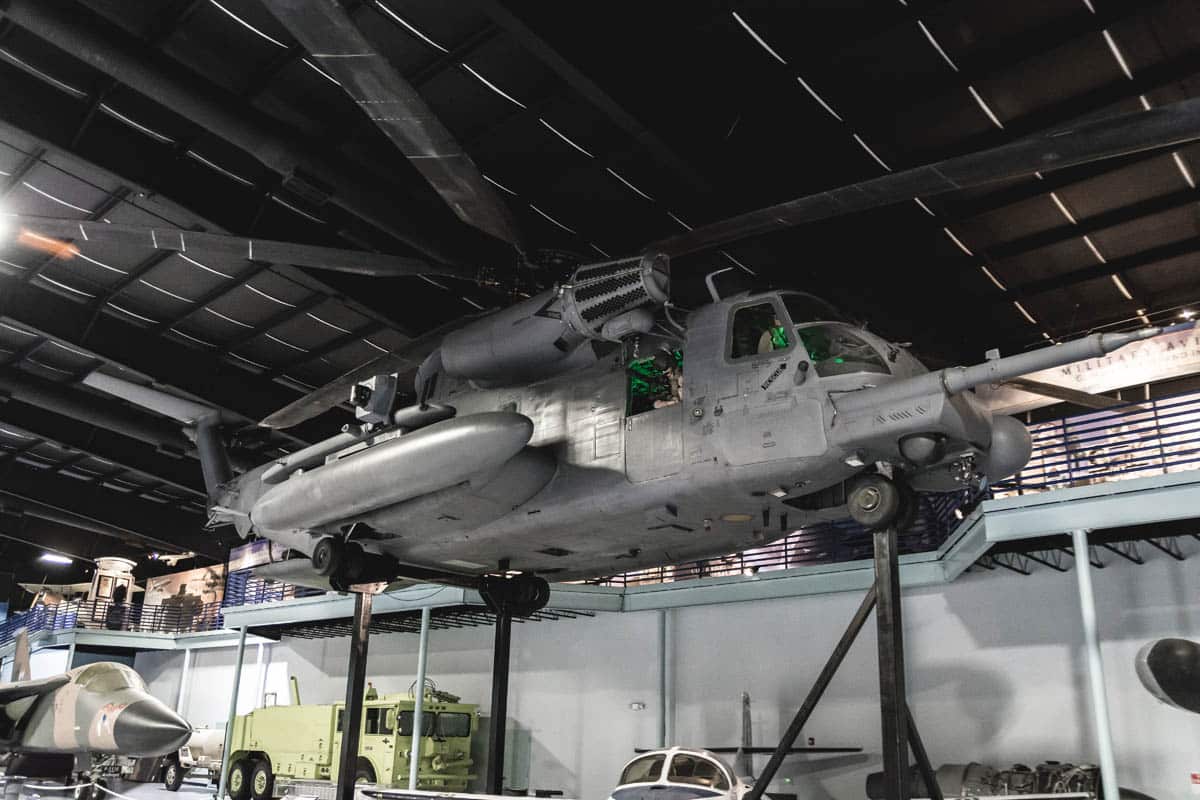Mh53 Pave Low - The Sikorsky MH-53 Pave Low series is a long-range special operations and combat search and rescue (CSAR) helicopter for the United States Air Force. The series was upgraded from the HH-53B/C, variants of the Sikorsky CH-53 C Stallion. The HH-53 "Super Jolly Gray Giant" was originally intended to replace the HH-3E "Jolly Gray Giant". The US Air Force MH-53J/M fleet was retired in September 2008.
The US Air Force ordered 72 HH-53B and HH-53C for search and rescue units during the Vietnam War, and later developed the MH-53J Pave Low variant for special operations missions.
Mh53 Pave Low

Pave Low's mission was to provide low-level, long-range, unpredictable access in hostile weather, day or night, to dead zones, for the infiltration, evacuation, and resupply of special operations forces. Pave Lows often served alongside the MC-130H Combat Talon for navigation, communications and combat support.
Aircraft 70 1629 (1970 Sikorsky Mh 53h Pave Low I C/n 65 339) Photo By Florida Metal (photo Id: Ac204257)
The large gray aircraft of the HH-53B earned it the nickname "Super Jolly Gray Giant". The name is a reference to the miniature HH-3E "Jolly Gray Giant", a stretched version of the H-3 Sea King, used for combat search and rescue (CSAR) operations in the Vietnam War.
The US Air Force has deemed its Sikorsky S-61R/HH-3E "Jolly Gray Giant" long-range CSAR helicopters compatible and is interested in the more capable S-65/CH-53A. In 1966, the USAF contracted Sikorsky to develop the CH-53A CSAR version.
An HH-53B of the 40th Air Rescue and Recovery Squadron refueling an HC-130P Hercules in North Vietnam, 1969-70.
Early HH-53Bs had T64-GE-3 turboshafts rated at 3,080 hp (2,297 kW), but these engines were later replaced by T64-GE-7s rated at 3,925 hp (2,927 kW). The turbocharger was upgraded. . A crew of five was standard, including a pilot, co-pilot, crew chief and two paramedics.
Sikorsky Mh 53j \
The HH-53B was originally an intermediate type, with production quickly transitioning to the Air Force's slightly improved HH-53C CSAR variant. The most visible difference between the HH-53B and the HH-53C was that the HH-53C used fuel tank mounting brackets. Experience with the HH-53B showed that the original tank was too large, which adversely affected performance when fully fueled, so it was replaced with a smaller 450 US gal (1,703 L). The tank has been accepted. Other changes include more weaponry and a more comprehensive suite of radios to improve communications with C-130 tankers, attack aircraft supporting CSAR operations and rescue aircraft on the ground. HH-53C was similar to HH-53B, with more potent T64-GE-7 genes.
A total of 44 HH-53Cs were built into service by August 1968. At the end of the war, they were fitted with countermeasures to deal with thermal missiles. Like the HH-53B, the HH-53C has been used for covert operations and interceptors, as well as reconnaissance drones. Some were assigned to support the Apollo space program, ready to recover an Apollo capsule in the event of a launch pad failure, although such an accident never occurred.
In addition to the HH-53Cs, the Air Force has acquired 20 CH-53C helicopters for other cargo operations. The CH-53C appeared to be very similar to the HH-53C, retaining the survivability wave, the most visible difference being that the CH-53C had no in-flight refueling check. Since the CH-53Cs were used for covert operations, they were armed and armored like the HH-53Cs.
PAVE or Pave is the Air Force code name for several weapon systems that use advanced electronics.
Sikorsky Mh 53j Pave Low Iii Enhanced Archives
The USAF's Super Jollies were useful helicopters, but they were essentially day/fair weather vehicles, and the crews of downed aircraft were often in trouble at night or in bad weather. A limited night/bad weather SSor system based on a low light level television (LLLTV) imager named Pave Low I was deployed to Southeast Asia in 1969 and combat evaluated on the Super Jolly. It worked, but the reliability was not enough. .
In 1975, the HH-53B was fitted with a much improved pave low II system and redesignated the YHH-53H. This exercise was very satisfactory, so eight HH-53Cs were fitted with the further improved system and redesignated the HH-53H Pave Low III, the YHH-53H was also upgraded to this specification. All were awarded in 1979 and 1980.
The HH-53H retained the in-flight refueling probe, external fuel tank, rescue hoist, and three gun armament of the HH-53C; Armament was usually one minigun on each side and a Browning .50 in (12.7 mm) gun in the tail to provide greater reach and lighter anti-armor capability. Improvements introduced by the HH-53H include:
FLIR and TFR are mounted on a unique "chin". The HH-53H can be fitted with 27 seats or 14 L for troops. The improvements were made by the Navy at Passacola, reflecting the fact that the Navy performed a high level of maintenance on Air Force S-65s. In 1986, the salvaged HH-53Hs were given an upgrade under the CONSTANT GRE program, which included incremental improvements such as a cockpit with blue-gray lighting compatible with night vision goggles (NVG). They were reclassified as "special operations" vehicles and given the new designation MH-53H accordingly.
Sikorsky Mh 53 Pave Low Usaf Solid Kiln Dried Mahogany Wood Handmade Desktop Display Scale Replica
The HH-53H proved itself, and the Air Force decided to order more, coming up with an improved MH-53J Pave Low III configuration. The general configuration of the MH-53J is similar to the HH-53J, the main changes being the installation of twin T64-GE-415 turboshafts with 4,380 shp (3,265 kW) and more armament, 1,000 lb (450 total). armor weight kg). There were also some avionics upgrades, including the installation of a modern Global Positioning System (GPS) satellite navigation receiver. A total of 31 HH-53Bs, HH-53Cs and CH-53Cs were upgraded to the MH-53J configuration between 1986 and 1990, all MH-53Hs were also upgraded, giving a total of 41 MH-53Js.
An MH-53J Pave Low IIIE of the 551st Special Operations Squadron, 58th Special Operations Wing, conducts a training mission.
A MH-53M Pave Low IV of the 21st Special Operations Wing approaches an MC-130P Shadow Combat Refueling Basket for in-flight refueling during a 2000 flood in Mozambique.

The MH-53J Pave Low III helicopter was the largest, most powerful, and most technologically advanced transport helicopter in the US Air Force inventory. Inertial navigation system with terrain tracking and terrain avoidance radar, forward infrared sor, global positioning system, projected map display enables the crew to follow terrain contours and avoid obstacles, allowing low-level penetration.
Sikorsky Mh 53m Pave Low Iv
As part of the Pave Low III program, the Air Force modified nine MH-53Hs and 32 HH-53s for night and inclement weather operations. Modifications include AN/AAQ-18 forward-looking infrared, inertial navigation system, global positioning system, Doppler navigation system, APQ-158 terrain tracking and terrain avoidance radar, on-board mission computer, enhanced navigation system and integrated avionics. were engaged for Precision Navigation to and from target areas. The Air Force designated these modified versions as the MH-53J.
The MH-53J's primary mission was to drop, supply, and transport special forces behind enemy lines. It can also assist in combat search and rescue missions. Low-level penetration was made possible by state-of-the-art terrain tracking radar as well as infrared sensors that allowed the helicopter to operate in adverse weather conditions. It was armored. It can carry 38 troops at a time and can carry up to 20,000 pounds (9,000 kg) of cargo on its external hook. It could reach a top speed of 165 mph (266 km/h) and had a ceiling of 16,000 ft (4,900 m).
The MH-53M Pave Low IV was modified from the MH-53J configuration with the addition of an Interactive Defense Aviation System/Multi-Mission Advanced Tactical Terminal, or IDAS/MATT. The system has increased the defensive capabilities of Pave Low. It provided instant access to the overall war situation through an almost real-time electronic order of combat updates. It also provided a new level of evasion detection with near-real-time threat on the horizon so crews could avoid and overcome threats and re-route if necessary.
While awaiting delivery of the HH-53Bs, the Air Force acquired two Marine CH-53As for evaluation and training. The first of eight HH-53Bs made its maiden flight on 15 March 1967, and the type was flying CSAR missions in Southeast Asia with the USAF Aerospace Rescue and Recovery Service until the 20th of the year. The Air Force calls the HH-53B the "Super Jolly." It was used for CSAR, covert combat operations, and for "clipping" double pods from photo-reconnaissance satellites.
A U.s. Air Force Mh 53 Pave Low Helicopter Sits On The Tarmac
The Air Force lost 17 Super Jollys during the Southeast Asian conflict, 14 were lost in combat, including one shot down by a North Vietnamese MiG-21 on a CSAR mission in Laos on 28 January 1970, and three were lost in accidents.
The Super Jollies made headlines in November 1970 for their failed raid in North Vietnam to rescue POWs from the Son Tay prison camp, as well as rescuing the crew of the cargo ship SS Mayaguez from Khmer Rouge fighters in Cambodia. May 1975.
The HH-53B, HH-53C, and CH-53C aircraft remained in Air Force service until the late 1980s. The Super Jollies operating on the front line were painted in various camouflaged color schemes, while those in the State Rescue Service were painted in a general gray scheme with a yellow tail.

The first nine HH-53H Pave Lowes were commissioned on 1 July 1980 and transferred from here.
Pave Low Dedicated Into Af Armament Museum > Hurlburt Field > Article Display
Mh-53 pave low helicopter, mh 53 pave low replacement, mh 53j pave low iii, pave low helicopter for sale, pave low helicopters, mh-53j pave low, sikorsky mh 53 pave low, pave low, pave low transformer, lego pave low, mh-53 pave low, ch 53 pave low
0 Comments